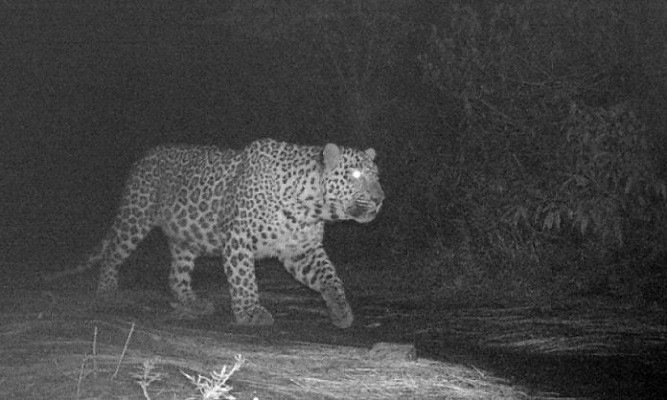
Sprawling over 17,000-hectare land, the biodiversity-rich Margalla Hills National Park has become a thriving habitat for the fading common Asian leopards.
Once the biome's migratory species that used to descend from Galiat and Ayubia National Park during heavy snowfall in winters and return to high altitudes in summers, the wildcats have been listed as endangered by the International Union for Conservation of Nature (IUCN).
The latest footage captured by a hidden camera of the Islamabad Wildlife Management Board once again ascertained the presence of this species at Margallas. The guardians of the national park had also initiated a study in the recent past to ascertain the presence of leopards in Margallas — a recreational abode for the capital residents.
Dwellers of the twin cities of Rawalpindi and Islamabad as well as those coming from other parts of the country frequently visit Margalla hills to enjoy their leisure time in the serene environment as well as for hiking and photography.
“The Margalla hills is a unique example of a leopard preserve zone near human settlement," said Special Assistant to the Prime Minister on Climate Change Malik Amin Aslam. He said Margalla hills has always been a source of attraction for visitors due to its rich habitat, unique biodiversity and comely atmosphere.
"Besides flora and fauna, we also have wildlife in this national park including common Asian leopard. “Amin Aslam said the federal government and wildlife department are vigilant of leopard's presence and continue efforts for its conservation.
"It is a success story of promising and dedicated conservation efforts that helped in preserving the critically endangered wildcat species,” he said.
The national park is home to over 600 plant species, medicinal herbs, shrubs, around 350 bird species, 300 mammals and 20 different assort of reptiles especially snakes that make it the undiscovered heaven of the Potohar region's biodiversity marvel.
Sunk into deep shrouds of foliage and green cover, the mesmerising trails of Margallas narrate the tale of biodiversity conservation, hunting, poaching of wildlife and preservation of natural heritage. “Maintaining and protecting the leopard preserve zone as an exclusive leopard habitat lying at a proximity to the capital city was a herculean task,” Islamabad Wildlife Management Board (IWMB) Chairperson Rina Saeed Khan said.
She said that “ecosystem restoration as advocated by the climate change experts was a challenging task and lockdowns during Covid epidemics made us avert adverse impacts environmental degradation in Margallas. We fully utilised this period for the conservation of Margallas and Trail-6 is now the leopard preserve zone with restricted and guided mobility.”
Read Scenic beauty of Margalla Hills under threat
"The temporary halt of human intervention also brought a boom in the revival of other animal and plant species. For decades, Margalla hills is a repository to wild boars, monkeys, barking deer, foxes, jackals, porcupines, Kalij pheasants and numerous plant species. Now with the arrival of leopards, they are also being provided with a living environment to embrace Trail-6 as their new abode.
According to the IWMB, there were two families of leopards in the Margalla Hills National Park comprising seven members. A female and two male leopards are exclusively residing in the leopard preserve zone given the names of Shehzada, Shehzadi and Sultan.
"Leopard is a shy animal that avoids human encounter in wild. It is nocturnal as it sleeps at daytime and hunts or patrols in the dark," IWMB board member Dr ZB Mirza.
He, however, advised the people venturing into Margalla hills not to put at risk their lives by unnecessarily teasing these wildcats by capturing their photos. "It is highly advisable to abstain from intruding into their area that may scare them resulting into deadly conflict".
A study carried out by the Quaid-i-Azam University students in 2019 said that leopards' presence in Margallas was not a threat rather it indicated a healthy ecosystem. "Leopards have emerged as the top predator ruling the food chain of Margalla Hills National Park and their thriving number has helped in maintaining balance among various other species," said IWMB manager operations Sakhawat Ali.
"Like any head of a tribe or clan, leopard is the boss or premier of Margalla hills." The Margalla Hills is a precious bounty of nature and its centuries-old trees grown in an abrupt dramatic manner reveal mysterious movie scenes showcasing the mighty jungle. I
ts indomitable rein of plants serves as lungs for capital residents absorbing carbon dioxide emitted by ever-increasing vehicular population.

1725523665-0/Minecraft-Movie-(1)1725523665-0-405x300.webp)



1732086766-0/BeFunky-collage-(74)1732086766-0-165x106.webp)





1732084955-0/Untitled-design-(64)1732084955-0-270x192.webp)









COMMENTS
Comments are moderated and generally will be posted if they are on-topic and not abusive.
For more information, please see our Comments FAQ